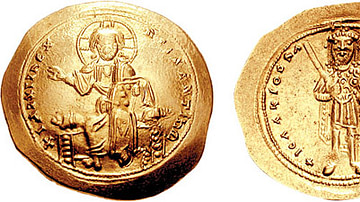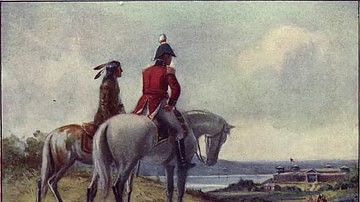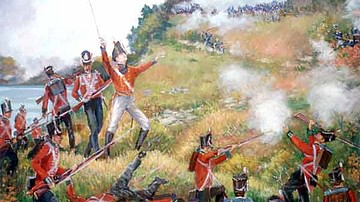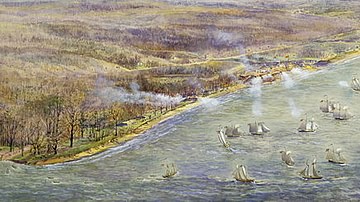The Battle of Queenston Heights (13 October 1812) was a major battle in the War of 1812. A US army, under General Stephen Van Rensselaer, crossed the Niagara River in an attempted invasion of Canada but was repulsed by a British, Canadian, and Mohawk force. The British victory came at the cost of General Isaac Brock, killed in the fighting.

Background: Fall of Detroit
In late June 1812, shortly after the United States had issued its declaration of war against the United Kingdom, the US began preparing for an invasion of British-controlled Canada. Ostensibly, the purpose of the invasion was to deprive Britain of a staging ground from where they could launch their own attack into US territory. But many of the 'War Hawks' – as the prowar faction in Congress was called – envisaged a more permanent outcome, believing that the invasion would result in Canada finally joining the Union. The annexation of Canada would greatly increase the United States' dominion over North America and would, in the words of one war-hungry congressman, "drive the British from our continent" (Berton, 98).
The invasion was to be four-pronged. Brigadier General William Hull, sitting with his 2,500-man army at Fort Detroit, would lead the first thrust, crossing over the Detroit River into Upper Canada (modern-day Southern Ontario). He would be followed by Major General Stephen Van Rensselaer, who would cross the Niagara River to capture Queenston, and by Major General Henry Dearborn, who would sail up Lake Champlain to capture Montreal, while a fourth US army crossed the St. Lawrence River to wreak havoc in Ontario. Most Americans believed it would be an easy campaign, that the Canadians, oppressed by the tyranny of British rule, would welcome their southern brethren with open arms. As former President Thomas Jefferson predicted, the invasion was expected to be nothing more than "a mere matter of marching" (Wood, 677).
But of course, it would not be so easy. General Hull began his invasion on 12 July, crossing over the Detroit River and establishing a base of operations at the small town of Sandwich, where he issued a proclamation calling on all Canadians to either join him or remain neutral. But Hull soon lost his nerve; deathly afraid of Native Americans, he was disturbed by reports of more Indigenous nations joining the British side and, moreover, feared that the arrival of enemy reinforcements could cut him off from US territory. On 8 August, after nearly a month of dithering on Canadian soil, he retreated to Detroit, where he was soon besieged by an Anglo-Indian force under Major General Isaac Brock and the great Shawnee chieftain Tecumseh. Brock and Tecumseh utilized psychological warfare to convince Hull that their army was larger than it really was, leading the American general to surrender both his army and Detroit without a fight on 16 August. The Siege of Detroit not only thwarted the first part of the US invasion but also left the British in control of the entire Michigan Territory.
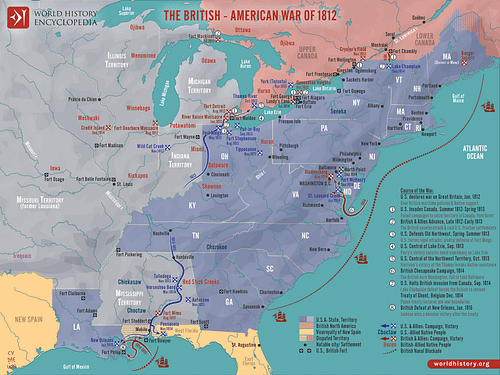
Hull was widely castigated for his defeat – indeed, he would later be court-martialed and sentenced to death, before the sentence was commuted to dismissal from the army. But he had at least set foot on Canadian territory, which was more than can be said about his counterparts. General Van Rensselaer had tried, but he did not have the necessary supplies or reinforcements to mount a successful crossing; what militia forces he did have refused to cross the Niagara, arguing that they were merely a defensive force and were not obliged to fight outside the United States. General Dearborn, likewise, was stuck at Albany, New York, unable to fill the enlistment quotas needed for an attack. "We have as yet a shadow of a regular force," his second-in-command would write, "inferior, even in numbers, to half of what the enemy already has in the field" (Taylor, 182). Dearborn was therefore relieved when, on 9 August, a British major arrived at his camp to offer an armistice. Dearborn readily accepted before passing along news of the armistice to President James Madison for his approval and instructing Van Rensselaer, his subordinate, to do nothing that might provoke the British. The invasion had, therefore, completely failed, leaving the US in a worse position as the armistice settled over the Niagara frontier.
The Savior of Upper Canada
On 23 August, General Brock triumphantly marched along the Canadian side of the Niagara River, herding the 500 American prisoners taken at Detroit before him to taunt the US soldiers on the opposite bank. Hailed as the 'Savior of Upper Canada', Brock certainly looked the part of a war hero – tall, muscular, and handsome, he was described by one man as being "exceedingly affable and gentlemanly, of a cheerful and social habit, partial to dancing, and although never married, extremely devoted to female society" (Taylor, 149). Stationed in Canada since 1801, Brock had watched with envy as his comrades in Europe covered themselves with military glory in battles against Napoleon, while he shivered his best years away on the remote fringes of the empire. But now, having tasted such glory at Detroit, Brock was eager for a second helping and sought to press on into the United States.
His ambitions would be frustrated not only by the armistice but also by his commanding officer, Lt. General Sir George Prevost. A more cautious man than the headstrong Brock, Prevost thought it wiser to stay on the defensive. He was convinced that the two nations were on the cusp of a peace treaty and did not want to ruin negotiations by invading the US. Despite Brock's protestations that this was the time to strike, that with the proper support he could "sweep everything before [him] from Fort Niagara to Buffalo", Prevost refused to be the first to break the armistice (Berton, 224). Finding himself leashed, Brock could do little but prepare his forces for a potential American attack. Consolidating his troops at the central point of Niagara, he established a line of beacons along the coast to warn him of any enemy movement. This accomplished, he could only sit and wait.
American Preparations
General Dearborn's armistice would not last long. On 15 August, President Madison dismissed it out of hand, refusing to entertain any peace offer that did not include a promise from Britain to stop impressing American sailors on the high seas. But before the armistice expired on 8 September, the Americans had successfully reinforced Van Rensselaer's army at Lewiston, a village directly across the Niagara River from the British outpost of Queenston. By mid-September, Van Rensselaer had a force of about 3,000 men, including militia and regulars, under his direct command, and was also nominally in charge of 1,700 more regulars under Brigadier General Alexander Smyth, located further upriver at Buffalo, New York. Now, with the armistice at an end, Van Rensselaer received orders from Dearborn to begin preparing for an attack, emphasizing that "at all events, we must calculate on possessing Upper Canada before winter sets in" (Taylor, 187).
General Stephen Van Rensselaer was not a natural soldier. He was, in fact, not a soldier at all; the scion of one of New York's oldest families, he was a politician who, earlier in the year, had announced his intention to stand for governor as a candidate for the Federalist Party on an antiwar platform. But, in a shrewd political move, his opponent – incumbent Governor Daniel D. Tomkins – got him out of the way by getting him appointed to the command of the Niagara army. This put Van Rensselaer in a lose-lose situation; should he refuse the appointment, he would be branded a pro-British coward, while an acceptance would greatly diminish the position of the antiwar Federalists in New York. He had, in the end, accepted the command, but only on the condition that his cousin, Colonel Solomon Van Rensselaer, serve as his aide-de-camp.
Now tasked with winning a war that they had opposed, the Van Rensselaer cousins were frustrated by the unruly condition of their army. In mid-September, they received an anonymous note, warning that the troops would mutiny if they were not paid in eight days. A series of torrential storms later that month further worsened morale and spread sickness throughout the camp. "We are, every few days, deluged in water," wrote Major John Lovett, a loyal friend and trusted aid to the Van Rensselaers. "Such storms of rain and wind I think I never experienced" (Taylor, 185). To make matters worse, General Smyth – who led the 1,700 regulars at Buffalo – considered General Van Rensselaer an amateur and refused to take orders from him. When Van Rensselaer sent Smyth plans for an attack, he refused to respond; when Van Rensselaer ordered Smyth to join him for a war council at Lewiston, he refused to come. This was blatant insubordination, but rather than waste time preparing a drawn-out court-martial, Van Rensselaer decided to forget about Smyth and begin planning an attack with what troops he had at hand in Lewiston.
Prelude to the Battle
On the night of 9 October, a small band of American sailors and artillerymen under Lt. Jesse Elliot left Buffalo and quietly rowed out to Fort Erie at the head of the Niagara River. There, they surprised and boarded two British brigs, Caldonia and Detroit, taking control of both after a brief fight with their crews. Although the Detroit ran aground and had to be burned to prevent it from recapture, the raid was a dashing success that raised American spirits across the Niagara frontier. More importantly, it put pressure on General Van Rensselaer to finally do something. He planned to cross the river on 11 October, hoping to seize the heights around Queenston before Brock could reinforce it. Another round of heavy storms delayed the attack, however, which was rescheduled for the morning of 13 October.

Brock, meanwhile, was growing restless. On 12 October, he sent one of his officers, Major Thomas Evans, to Lewiston to propose a prisoner exchange, ordering him to take note of anything important he observed while in the American camp. Upon arriving in Lewiston, Evans presented his request to Major Lovett, who replied that no prisoner exchange could be conducted until "the day after tomorrow". Evans was offput by Lovett's phrasing, with his suspicions only deepening when he spotted a row of boats hidden beneath brush along the shoreline. That evening, Evans reported his findings to General Brock at Fort George, telling him that he expected an American attack on the 13th. Although Brock's other senior officers laughed at Evans, the general took him seriously and ordered his troops to begin concentrating at Fort George, where he expected the attack to take place. After sending these orders, Brock continued to work well into the night. He had only just gone to bed when he was awoken, early on the morning of 13 October, by the distant sound of cannons.
The Battle Begins
At 3 a.m. on 13 October, 13 boats paddled silently across the Niagara River, loaded with 100 New York militiamen and 300 US regulars. Though three were swept downriver by the current, ten landed at the disembarkation point of Queenston. Colonel Solomon Van Rensselaer, entrusted by his cousin with leadership of the first wave of the attack, leaped from his boat – and was immediately struck in the thigh by a musket ball. A British sentry had noticed the oncoming American boats and had rushed to alert his commanding officer, who had managed to get 46 regulars and several Canadian militiamen into position on the heights above Queenston in time to contest the landing. Volleys of musket fire rained down on the Americans, pinning them to the riverside. Colonel Van Rensselaer did his best to rally his troops but was shot four more times and was rushed back across the river to a field hospital. Atop the heights, a British battery – situated within an arrow-shaped embankment known as a redan – opened fire on the American troops, and was soon answered by the American artillery, which thundered from atop the Lewiston Heights across the river.
As the rays of dawn brightened the sky, the British cannons could take better aim at the second wave of American boats, which was now crossing the river. One boat was blown clean out of the water, with 15 men killed in the blast, while three other boats carrying 80 men were swept 800 yards downriver, coming ashore in a hollow. Here, the confused American troops were surrounded and fired on by Canadian militia; Colonel John Fenwick, in charge of the second wave of American boats, took a pistol ball to the face, with most of his men killed or wounded. It soon became clear that the British battery would have to be neutralized if the Americans were to have any hope of landing more troops. The task fell to 23-year-old Captain John E. Wool, who rallied the American survivors at the initial landing zone and led them in a charge up the high ground. Wool stormed the redan and seized the British cannons, chasing the Anglo-Canadian defenders from the heights.
It was at this moment that General Brock, roused from his sleep by the roar of cannons, arrived on the scene. The appearance of the 'Savior of Upper Canada' immediately raised the morale of the British troops gathering in Queenston; as the general galloped through the village streets, he was cheered by the men of the 49th Regiment of Foot, his old regiment. Realizing that the heights would need to be retaken, Brock drew his sword and ordered the 49th Regiment and the 2nd Regiment of York militia to follow him in a charge. The British were partway up the hill when they were checked by a hail of bullets from Wool's men. The British regulars started to waver and were on the point of retreating, when Brock harangued them, shouting: "This is the first time I have ever seen the 49th turn their backs!" (Berton, 250).
As Brock stood there trying to rally his men, he made an easy target. He was shot first through the wrist as he waved his sword about his head. Then, an American soldier leaped out from behind a thicket and shot Brock in the chest from a distance of 50 yards (45 m). By the time his soldiers came close enough to check on him, Brock was dead; the British and Canadian soldiers retreated from the hill, carrying the corpse of their gallant general with them.

At the foot of the heights, some of the fleeing soldiers were rallied by Brock's aide-de-camp, Lt. Colonel John Macdonell. With shouts of "revenge for the general!", Macdonell led them in a second charge up the hill. Macdonell was knocked from his horse by a bullet – he would die the next morning – with many of the other British officers also taking wounds. The dispirited British troops fell back once again, leaving the Americans in possession of the heights.
The Tide Turns
After the failure of Macdonell's charge, a lull descended on the battle as each side rushed to send in reinforcements. General Van Rensselaer, watching the battle from the American side of the river, knew he had to send in more troops if he meant to keep control over Queenston Heights. But, when he attempted to send his militiamen across the river, most of them refused, arguing once again that they were not obligated to fight outside the boundaries of New York State. As Van Rensselaer wasted precious time arguing with his militia, the British – now led by Major General Roger Hale Sheaffe – successfully brought in fresh reinforcements from nearby Chippawa and Fort George. Also arriving on the battlefield on the British side were 300 Mohawk warriors, led by John Norton and John Brant. In all, Sheaffe had some 1,200 soldiers compared to a roughly similar number of Americans.
Command of the American troops atop Queenston Heights was assumed by Lt. Colonel Winfield Scott of the 2nd Artillery, who hastily prepared for the coming assault by putting up a makeshift barricade of wood and fence rails. At 4 p.m., General Sheaffe finally launched his counterattack; red-coated British regulars stormed up the hill, this time charging side by side with screaming Mohawk warriors. The presence of the Mohawks terrified the Americans, with one soldier later writing, "I thought hell had broken loose and let her dogs of war upon us" (Taylor, 189). It did not take long for the Americans to break; they retreated en masse, and in the panic, some soldiers flung themselves off the heights to their deaths in the icy river below. To prevent a massacre, Scott surrendered to Sheaffe, ending the Battle of Queenston Heights in a British victory after twelve long hours of fighting. The Americans lost 90 killed, 100 wounded, and 925 captured, while British casualties amounted to 19 killed, 77 wounded, and 21 captured.
Conclusion
The Battle of Queenston Heights, the first major land engagement of the war, was a significant British victory. It thwarted yet another American incursion into Canada and lowered morale across the United States. General Van Rensselaer resigned his command immediately after the battle while his superior, General Dearborn, suspended any plans for another Canadian invasion. But this great victory came at the cost of Brock, the best British commander in North America, whose loss would be sorely felt in the coming years of war.






